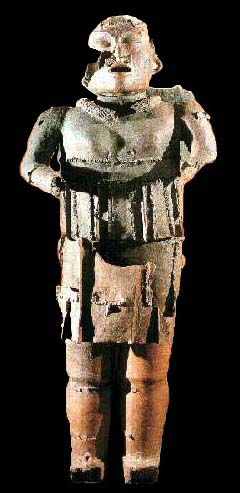|
Man is gods creador, he transforms fireclay and rock in the form of there gods, they give them life in multiple forms and faces of the anchient gods; the same way that man transforms his creative force in there gods, the paradox is that the gods where the ones that created man.
El hombre es el gran hacedor de dioses. Transforma el barro y la piedra para crearlos a su imagen y semejanza; les da vida plasmada de esta manera en los múltiples rostros de los dioses antiguos. Así como el hombre transfiere su poder creador a los dioses, paradójicamente son los dioses quienes dan vida al hombre.
|
Tláloc
Dios de la lluvia y de la fertilidad.
The Rain god and fertillity

Xipe-Tótec
Tlacaxipehualiztli o fiesta del "deso-llamiento de hombres", se celebraba en la segunda veintena del año. Los ritos de desollamiento estaban dedicados al dios Xipe-Tótec, dios de la primavera, pues la tierra debe cambiar su piel muerta por una fresca que permita el surgimiento de nueva vegetación.
The "des-ollamiento" celebrations took place in the second 20 days of the year, the rituals where dedicated to the god "Xipe-Tótec", god of the spring, the grownd has to change his dead skin in order to reveal the fresh one and permit the rising of new vegetation
Huehuetéotl-Xiuhtecuhtli
Dios viejo y del fuego, Señor del año. Se le ve en forma de un anciano desdentado y barbado en posición sedente. Con un brasero sobre su espalda.
The old god and the god of fire, the god of the year. He apears in the form of an old, fragile and bearded man.
Cihuateteo
La región oeste del universo recibía el nombre de Cihuatlampa o "rumbo de las mujeres", el cual se identificaba por el color blanco, el glifo calli o "casa" y estaba presidido por el dios Quetzalcóatl. A las mujeres de esta región
The west region of the universe had the name Cihuatlampa or "road to the women" , it was identified with the color "white". Calli or "house" and the women of this reagion where ruled by Quetzalcoatl.
Cilindro maya
El oriente era la casa por donde nace el sol. Esa región se identifica con el color rojo, el glifo ácatl o "caña" y estaba presidido por el dios Xipe-Tótec.
The orient was the house in wich the sun was born. This reagion was identified with the color "red".
Sacerdote de la muerte
The death priest
El lado norte es el Mictlán, rumbo de los muertos; se identificaba con el color negro, el glifo técpatl o "cuchillo de sacrificio" y lo preside el Tezcatlipoca negro.
The north of Mictlan, road to the dead; is identified with the color "black".
Tláloc mixteca
El lado sur del universo se identificaba con el color azul, el glifo tochtli, o "conejo" y estaba presidido por Tláloc, el dios de la lluvia.
The south side of the universe was identified with the color "blue".
|

